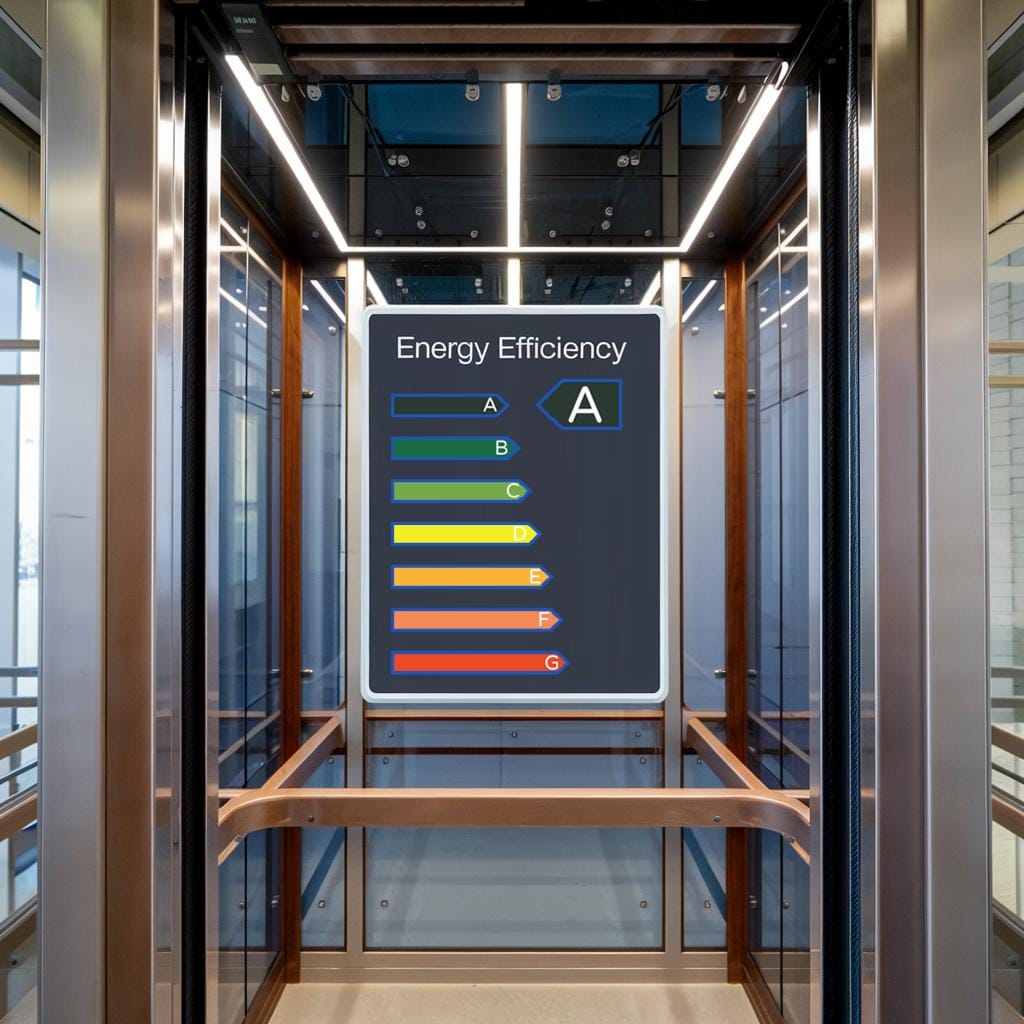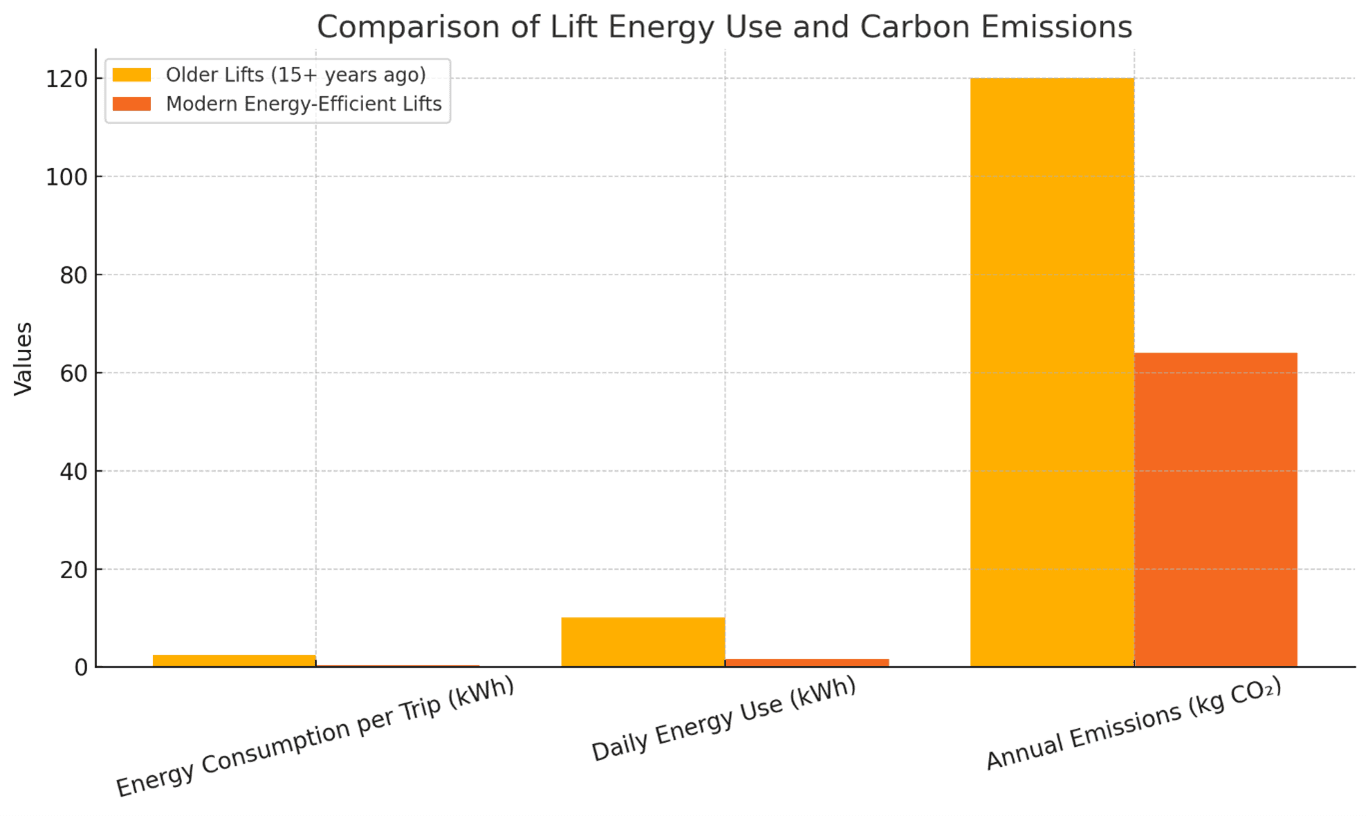February 10, 2025
We look at how much energy a modern lift uses in 2025

We recently revisited an old blog article exploring lift energy consumption and CO2 impact, sparking curiosity about how much progress has been made since then.
The sources to those articles can be found at the end of this article.
Over fifteen years ago, the energy efficiency of lifts and the carbon emissions they caused was an issue of concern. This article will look at how much has changed in that time and demonstrate how lifts are now incredibly energy efficient
Advancements in lift technology have significantly reduced the energy consumption and carbon footprint of vertical transportation in buildings. While older lifts were relatively inefficient, modern designs employ energy-saving innovations that have greatly reduced emissions and costs to run.
There are many types of different lifts but in this article we will explore how much energy modern passengers lifts consume, the carbon emissions associated with their operation, and how they compare to their predecessors.
The Basics of Lift Energy Use
The energy consumption of a lift depends on several factors:
- Building height and lift travel distance: Taller buildings require more energy for longer trips.
- Lift load: Lift cabins empty at the top of a lift shaft travelling down or carrying maximum weight at the bottom going up consume the most energy at these points.
- Lift technology: Modern machine-room-less lifts and those with regenerative drives are far more efficient than older hydraulic systems.
- Usage patterns: Frequent stops, standby power, and the number of trips all add to the total energy consumed.
Modern Lifts: A Leap in Energy Efficiency
Recent advancements in lift technology have revolutionised energy efficiency, making them greener and more sustainable. Here are three key innovations driving this transformation:
- Machine-Room-Less (MRL) Lifts
Modern lifts often eliminate the bulky machine room by incorporating the motor directly into the lift shaft. This reduces both space requirements and energy consumption. - Regenerative Braking
One of the biggest innovations in lift technology is regenerative braking. This system captures the energy generated when a lift travels downward with a heavy load or upward with a light load, converting it back into usable electricity for the building. - Standby Power Reduction
Older lifts consumed a significant amount of energy even when idle. Modern systems use intelligent standby modes, dramatically lowering their consumption during periods of inactivity.
Energy Consumption of Modern Lifts: 2025 vs 2007
Energy Consumption of Modern Lifts: 2025 vs 2007
Using current data, we can estimate the energy consumption of modern lifts and compare it with adjusted figures for older systems based on the same number of floors.
Energy Per Trip
Modern Lifts 2025:
A modern lift in a mid-rise building (5–10 floors) consumes approximately 0.0039 to 0.075 kWh per round trip, reflecting significant energy efficiency advancements.
Lifts in 2007:
Based on scaling down from 20-floor data, 2007 lifts would consume approximately 0.02375–0.0475 kWh per round trip.
Comparison: Modern lifts consume up to 83% less energy per trip than 2007 systems when operating in the same conditions. This improvement is due to advanced technologies like regenerative braking and more efficient motors.
Daily Energy Use
Modern Lifts 2025:
Assuming four rides per person per day (e.g., to work, out for lunch, back, and home), modern lifts consume approximately 0.016–0.3 kWh per person per day.
Lifts in 2007:
With the adjusted energy use of 0.02375–0.0475 kWh per trip, older lifts would consume 0.095–0.19 kWh per day for four trips.
Comparison: Modern lifts use up to 83% less daily energy than 2007 lifts, demonstrating their superior efficiency for regular usage.
Annual Energy Use
Modern Lifts 2025:
Over a working year (200 days), modern lifts consume approximately 3.2–60 kWh per person.
Lifts in 2007:
Older lifts would consume 19–38 kWh annually under the same conditions.
Comparison: While modern lifts have a similar range of annual consumption for lower-end usage, their advanced features make them significantly more efficient under higher usage scenarios.
Carbon Emissions: A Modern Perspective
The carbon emissions associated with lift use depend on the carbon intensity of the electricity grid. Using the UK’s current grid average of 0.2 kg CO₂ per kWh, we can calculate emissions for both modern and older systems.
Daily Emissions
Modern Lifts 2025: 0.0032–0.06 kg CO₂ per person per day.
Lifts in 2007: 0.019–0.038 kg CO₂ per person per day.
Comparison: Modern lifts emit up to 84% less CO₂ daily, reflecting their energy efficiency and reduced reliance on inefficient systems.
Annual Emissions
Modern Lifts 2025: 0.64–12 kg CO₂ per year for 200 working days.
Lifts in 2007: 3.8–7.6 kg CO₂ annually.
Comparison: Modern lifts produce significantly lower annual emissions, particularly for higher usage levels, thanks to energy-saving innovations and cleaner grid electricity.
Future Innovations
Looking ahead, the integration of AI for traffic optimisation, solar-powered lifts, and further improvements in energy efficiency could make lifts almost entirely carbon-neutral. As buildings grow taller and cities densify, these technologies ensure that vertical transportation remains sustainable.
So, next time you step into a lift, rest assured: modern engineering is doing its part to keep the ride efficient and eco-friendly!

Sources: https://www.theguardian.com/environment/blog/2009/sep/04/lifts-energy-take-the-stairs, https://fatknowledge.blogspot.com/2007/02/how-much-energy-does-elevator-use.html
